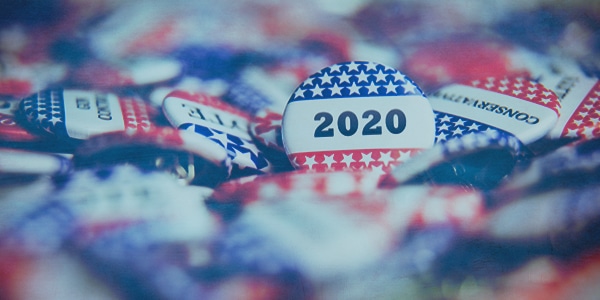Political Advertising: The Role of Data in Reaching Voters Beyond Party Affiliation

- With data, political advertisers can connect with specific voters based on interests beyond their political party.
- Analysis leveraging the Viant Total Graph and DSP showed changes in Democrats’ and Republicans’ brand preferences from 2016 to 2020.
- As an omnichannel DSP, Viant enables political advertisers to reach consumers across all of their devices without the restrictions imposed by other technologies.
Both major parties are spending big on the 2020 presidential election, with ad spend expected to be $6.89 billion in 2020, up 63% from 2016, and breaking another political advertising election record.
To keep their messaging fresh, politicians on both sides of the aisle need to take the time to understand their constituents—not just the party they belong to, but the products they buy, TV shows they watch, and more. In doing so, marketers can help campaigns branch out and connect with specific voters based on their interests.
As part of this effort to illustrate the types of data campaigns can capitalize on, we used the Viant Total Graph, powered by a database of over 250 million registered users and 115 million households, to glean insights on Democrats’ and Republicans’ brand preferences. This project demonstrated how marketers leverage omnichannel capabilities to reach specific consumer segments.
By combining this data with a similar analysis from before the 2016 election, we could account for the new voter pool and understand changes in voter preferences from one presidential election cycle to the next. These updated statistics give campaigns a more accurate picture of the breadth of people they can target. So how polarizing are the parties’ purchasing habits?
When Pet Ownership and Soda Preferences Get Political
Republicans are 25% more likely to own a dog and 27% more likely to own a cat than Democrats. The numbers are less skewed than in 2016 when the statistics were 41% for dogs and 32% for cats. When it comes to feeding our furry friends, Democrats do not prefer specific pet food brands, but Republicans are more likely to choose Hill’s Science Diet or IAMS Healthy Naturals—Arm & Hammer was on top four years ago.
It might seem strange that pet ownership is political, but this schism could be a product of geography. Democrats are more likely to live in urban areas without yards, which means they have less physical space to support man’s best friend.
Another notable division occurs when consumers curl up with their pets to watch TV. As in 2016, Democrats are more likely to watch science fiction or fantasy shows like American Horror Story and The Vampire Diaries. The COVID-19 pandemic likely accelerated this trend, as consumers binged on media while stuck at home.
Republicans’ TV tastes run the gamut, from intense shows like Alone and Vikings to relaxing home improvement, cooking, or gardening shows. They are also massive sports fans who view baseball, soccer, and hockey more regularly than Democrats.
While watching TV, Democrats prefer to sip Crush or Fanta. By contrast, Republicans are diet soda drinkers. They are 84% more likely to consume Diet Pepsi and Coke Zero (an increase from 70% in 2016).
Dishing on Politics
Political party preference goes far beyond the debate stage, delving into the products voters use in their day-to-day lives. From candy and clothes to cars and dish detergent, advertisers can leverage this first-party data to reach specific constituents at just the right moments.
Democrats love to splurge on sweets—they are 83% more likely to purchase upscale candy brands like Ferrero Rocher. But Republicans stick with the classics like Reese’s Peanut Butter Cups, M&Ms, and Hershey’s Kisses.
This dichotomy also plays out at the clothing store. Democrats are 54% more likely to buy apparel from Levi Strauss Signature and 40% more likely to purchase from H&M. Republicans prefer sporty exercise brands like Under Armour, Columbia Sportswear, Nike, and Adidas.
When hitting the road, Democrats are more than twice as likely to drive foreign brands like Nissan or Toyota. Republicans get behind the wheel of domestic brands like Jeep, GMC, and Ford.
The most significant partisan divide, however, is over consumer-packaged goods like dish detergent. As they did four years ago, Democrats have a strong affinity for Ajax, purchasing it 91% more than any other brand (down from a whopping 140% in 2016). Republicans prefer Finish by a comparatively mild 44% margin; Cascade is a close second.
All politics is ultimately local, and all advertising is too. As a result, marketers need to keep target audiences’ preferences in mind when creating content. The more brands know about core consumer bases, the better the return on investment for digital ads will be. That business philosophy is one of the few principles with bipartisan support.
STAY IN THE LOOP WITH OUR NEWSLETTER
Sign up to get Viant news and announcements delivered straight to your inbox.
Sign up to get Viant news and announcements delivered straight to your inbox.
